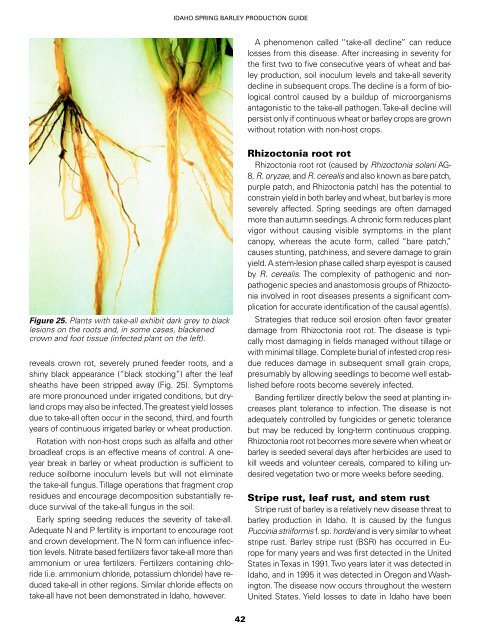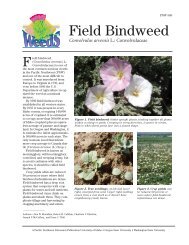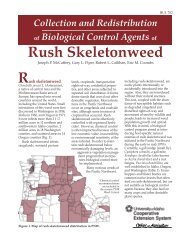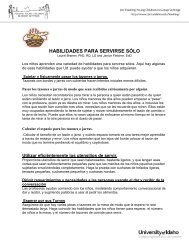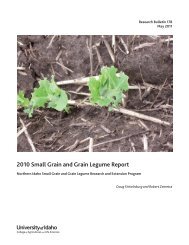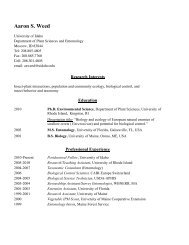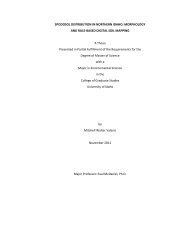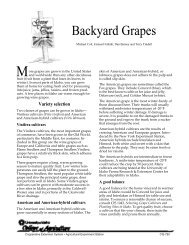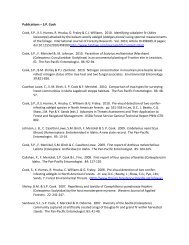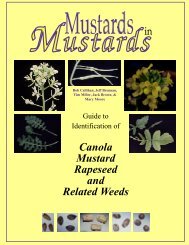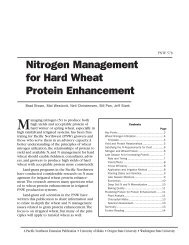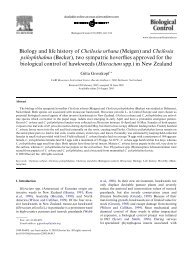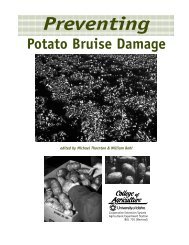Spring Barley Production Guide - College of Agricultural and Life ...
Spring Barley Production Guide - College of Agricultural and Life ...
Spring Barley Production Guide - College of Agricultural and Life ...
You also want an ePaper? Increase the reach of your titles
YUMPU automatically turns print PDFs into web optimized ePapers that Google loves.
Figure 25. Plants with take-all exhibit dark grey to black<br />
lesions on the roots <strong>and</strong>, in some cases, blackened<br />
crown <strong>and</strong> foot tissue (infected plant on the left).<br />
reveals crown rot, severely pruned feeder roots, <strong>and</strong> a<br />
shiny black appearance (“black stocking”) after the leaf<br />
sheaths have been stripped away (Fig. 25). Symptoms<br />
are more pronounced under irrigated conditions, but dryl<strong>and</strong><br />
crops may also be infected. The greatest yield losses<br />
due to take-all <strong>of</strong>ten occur in the second, third, <strong>and</strong> fourth<br />
years <strong>of</strong> continuous irrigated barley or wheat production.<br />
Rotation with non-host crops such as alfalfa <strong>and</strong> other<br />
broadleaf crops is an effective means <strong>of</strong> control. A oneyear<br />
break in barley or wheat production is sufficient to<br />
reduce soilborne inoculum levels but will not eliminate<br />
the take-all fungus. Tillage operations that fragment crop<br />
residues <strong>and</strong> encourage decomposition substantially reduce<br />
survival <strong>of</strong> the take-all fungus in the soil.<br />
Early spring seeding reduces the severity <strong>of</strong> take-all.<br />
Adequate N <strong>and</strong> P fertility is important to encourage root<br />
<strong>and</strong> crown development. The N form can influence infection<br />
levels. Nitrate based fertilizers favor take-all more than<br />
ammonium or urea fertilizers. Fertilizers containing chloride<br />
(i.e. ammonium chloride, potassium chloride) have reduced<br />
take-all in other regions. Similar chloride effects on<br />
take-all have not been demonstrated in Idaho, however.<br />
IDAHO SPRING BARLEY PRODUCTION GUIDE<br />
42<br />
A phenomenon called “take-all decline” can reduce<br />
losses from this disease. After increasing in severity for<br />
the first two to five consecutive years <strong>of</strong> wheat <strong>and</strong> barley<br />
production, soil inoculum levels <strong>and</strong> take-all severity<br />
decline in subsequent crops. The decline is a form <strong>of</strong> biological<br />
control caused by a buildup <strong>of</strong> microorganisms<br />
antagonistic to the take-all pathogen. Take-all decline will<br />
persist only if continuous wheat or barley crops are grown<br />
without rotation with non-host crops.<br />
Rhizoctonia root rot<br />
Rhizoctonia root rot (caused by Rhizoctonia solani AG-<br />
8, R. oryzae, <strong>and</strong> R. cerealis <strong>and</strong> also known as bare patch,<br />
purple patch, <strong>and</strong> Rhizoctonia patch) has the potential to<br />
constrain yield in both barley <strong>and</strong> wheat, but barley is more<br />
severely affected. <strong>Spring</strong> seedings are <strong>of</strong>ten damaged<br />
more than autumn seedings. A chronic form reduces plant<br />
vigor without causing visible symptoms in the plant<br />
canopy, whereas the acute form, called “bare patch,”<br />
causes stunting, patchiness, <strong>and</strong> severe damage to grain<br />
yield. A stem-lesion phase called sharp eyespot is caused<br />
by R. cerealis. The complexity <strong>of</strong> pathogenic <strong>and</strong> nonpathogenic<br />
species <strong>and</strong> anastomosis groups <strong>of</strong> Rhizoctonia<br />
involved in root diseases presents a significant complication<br />
for accurate identification <strong>of</strong> the causal agent(s).<br />
Strategies that reduce soil erosion <strong>of</strong>ten favor greater<br />
damage from Rhizoctonia root rot. The disease is typically<br />
most damaging in fields managed without tillage or<br />
with minimal tillage. Complete burial <strong>of</strong> infested crop residue<br />
reduces damage in subsequent small grain crops,<br />
presumably by allowing seedlings to become well established<br />
before roots become severely infected.<br />
B<strong>and</strong>ing fertilizer directly below the seed at planting increases<br />
plant tolerance to infection. The disease is not<br />
adequately controlled by fungicides or genetic tolerance<br />
but may be reduced by long-term continuous cropping.<br />
Rhizoctonia root rot becomes more severe when wheat or<br />
barley is seeded several days after herbicides are used to<br />
kill weeds <strong>and</strong> volunteer cereals, compared to killing undesired<br />
vegetation two or more weeks before seeding.<br />
Stripe rust, leaf rust, <strong>and</strong> stem rust<br />
Stripe rust <strong>of</strong> barley is a relatively new disease threat to<br />
barley production in Idaho. It is caused by the fungus<br />
Puccinia striiformis f. sp. hordei <strong>and</strong> is very similar to wheat<br />
stripe rust. <strong>Barley</strong> stripe rust (BSR) has occurred in Europe<br />
for many years <strong>and</strong> was first detected in the United<br />
States in Texas in 1991. Two years later it was detected in<br />
Idaho, <strong>and</strong> in 1995 it was detected in Oregon <strong>and</strong> Washington.<br />
The disease now occurs throughout the western<br />
United States. Yield losses to date in Idaho have been


